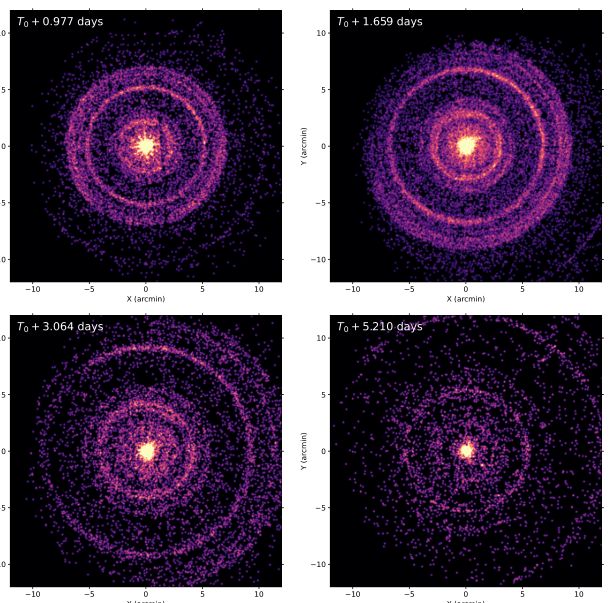A record-breaking gamma-ray burst detected in October 2022 has now been described as a one-in-a-thousand years event.
It's called GRB 221009A, and with up to 18 teraelectronvolts of energy packed in its emissions of light, it's considered the most powerful gamma-ray burst on record.
We've been waiting to learn more about this incredible explosion, and now the analyses have started to arrive on preprint server arXiv, with a trio of papers submitted to The Astrophysical Journal Letters.
According to the analyses, this exceptional burst of light is breaking rules: the light curve of its afterglow doesn't neatly adhere to theoretical descriptions of how it should go, suggesting that there's something interesting and unique about GRB 221009A.
To recap, gamma-ray bursts are the most violent explosions in the Universe, erupting in fire and fury so powerful they release more energy than the Sun would in 10 billion years. The outbursts of electromagnetic radiation are caused by cataclysmic events: the supernova or hypernova explosions massive stars undergo at the end of their lifetimes, or collisions of binary systems involving at least one neutron star.
GRB 221009A was first detected on 9 October 2022, and was initially thought to be a less powerful flash of X-rays from a relatively nearby source. Follow-up, however, revealed that the flash of light traveled from much farther than first thought – 2.4 billion light-years (which still makes it one of the closest gamma-ray bursts ever detected) – meaning that it was also much more powerful than first thought.
In the 73 days following the initial discovery, astronomers watched it eagerly, tracking the evolution of its light curve; the shape the light's intensity makes on a graph over time. They had to stop after around the 70-day mark because the afterglow moved behind the Sun, but is due to re-emerge around about now.

In a paper led by Maia Williams of Pennsylvania State University, a team of astronomers found that the X-ray afterglow of GRB 221009A in the immediate aftermath of the burst was the brightest ever detected by the Swift observatory, by an order of magnitude. In a simulation of randomly generated bursts, only one in 10,000 was as powerful as GRB 221009A.
Once distance was factored in, the brightness of GRB 221009A was consistent with other gamma-ray bursts in the Swift catalog. Others just appear dimmer because they're farther away. According to the team's calculations, it's the combined characteristics of GRB 221009A that make it very rare indeed.
"We estimate," they write, "that GRBs as energetic and nearby as GRB 221009A occur at a rate of ≲1 per 1000 yr – making this a truly remarkable opportunity unlikely to be repeated in our lifetime."
What makes the GRB truly peculiar is the evolution of the afterglow, which doesn't fit the standard theory. Gamma-ray bursts are typically followed by the glow of electrons moving at near-light speeds. Referred to as a synchrotron emission, it's the result of the shocks that form as the initial explosion slams into the interstellar medium.
The gamma-ray bursts themselves are thought to consist of energy concentrated in parallel rays that form highly collimated jets. Studying the ensuing synchrotron emission can help astronomers figure out the shape of the explosion and the jets.
According to Williams and her team, the afterglow suggests that either the jet structure of GRB 221009A is either more complicated than expected, or isn't narrowly collimated. The latter scenario, they say, will have profound implications for the event's energy budget.
In another paper led by Tanmoy Laskar from the University of Utah, a team of astronomers suggests that the peculiar afterglow could mean that there's an additional source of synchrotron emission in the afterglow of the gamma-ray burst, but the implications could also be more serious. The problem, they suggest, could be something fundamentally wrong with synchrotron afterglow theory.
And a third paper led by astronomer Manisha Shrestha from the University of Arizona finds that the afterglow doesn't contain some of the features you'd expect to see in a supernova explosion. This, they find, could mean that most of the energy budget of GRB 221009A was spent on the jets, leaving very little behind to suggest an exploding star was responsible.
The afterglow is expected to re-emerge from behind the Sun this month, and is expected to still be very visible to our telescopes in multiple wavelengths. Whatever is going on with this peculiar explosion, astronomers are going to be working very hard to get to the bottom of it.
The research papers have all been submitted to The Astrophysical Journal Letters, and are available on preprint server arXiv. They can be found here, here, and here.
